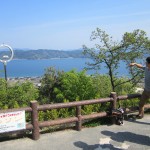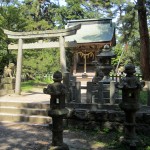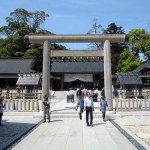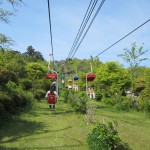Amanohashidate (天橋立 – Japan’s “heavenly bridge”) is one of the renowned three views of Japan (日本三景), yet due to its location on the often-neglected Sea of Japan coast it often doesn’t make the cut for many sightseers’ itineraries. Most Japanese haven’t even been there, and a surprising number aren’t exactly sure where it is. But after going there myself I can declare that it’s one of the most pleasant excursions I’ve been on and more than worth the effort.
What’s special about Amanohashidate?
 The main attraction is of course that long, straight sandbar that stretches straight across the bay. You’ll want to check out the view from Kasamatsu Park, which is the scenic point on the end opposite from where the train station is; the view is the one you see most often on post cards, pamphlets and such, and getting there is half the fun.
The main attraction is of course that long, straight sandbar that stretches straight across the bay. You’ll want to check out the view from Kasamatsu Park, which is the scenic point on the end opposite from where the train station is; the view is the one you see most often on post cards, pamphlets and such, and getting there is half the fun.
But it’s the plus-alpha elements that really sold me on Amanohashidate. First of all, it’s not overcrowded. I suppose that’s the upside of a location that’s a little hard to access. So many tourist spots around Japan are so extremely dense, lines are long and you just feel rushed. You’re by no means alone in Amanohashidate, but you can explore at your own pace and really have room to breathe.
 There’s a bunch of fun little things to see and do as you tour the area, too. I highly recommend renting a bicycle for the day to get across and back. The ski-lift-style ride up to and down from the overlook is tranquil and adorable, and at the top there’s a hoop that people try to throw clay discs through, great for children and inner children alike. (but I’ll warn you it’s much more difficult than it looks)
There’s a bunch of fun little things to see and do as you tour the area, too. I highly recommend renting a bicycle for the day to get across and back. The ski-lift-style ride up to and down from the overlook is tranquil and adorable, and at the top there’s a hoop that people try to throw clay discs through, great for children and inner children alike. (but I’ll warn you it’s much more difficult than it looks)
It’s interesting to watch all the people bending over to see the view upside-down; supposedly looking at it this way makes it seem like the peninsula is ascending through the sky to heaven. Sure, you could just turn a post-card upside down, but where’s the fun in that?
Of course there are cute tourist shops too. Preserved porcupine fish seem to be a popular souvenir. And there’s a shop that specializes in Japanese (grape) wine, which you don’t usually see a lot of even in Japan. Naturally, there’s nice temple (Chionji) before you cross and a nice shrine (Kono) on the far side which keep the traditional Japanese travel atmosphere alive.
Getting there and back
If you’re starting from Kyoto/Osaka or even Nagoya (provided you take the shinkansen to Kyoto), you can do Amanohashidate as a day trip, but if your base of operations is in Tokyo, you’d better make it an overnighter. Day-trippers should also be advised against trying to walk the sandbar; definitely go for the bicycle.
The 2-hour-long somewhat scenic train ride starts from Kyoto station. If you buy your tickets normally (don’t have a JR pass), there isn’t a problem. But if you’re traveling with a JR pass, note that it only gets you as far as Fukuchiyama station, after which you’ll need 1520 yen each way (but you won’t need to change trains, just pay the attendant that comes through the cabin).
Trains to Amanohashidate leave about once every hour before noon, so no problem there. However, be sure to get a reserved seat ticket and make it clear you’re going to Amanohashidate. Why? The train will split at Ayabe station, and you need to be on the correct train car.
On your return, the train you want is the JR Limited Express Hashidate #10 (JR特急はしだて10号), which departs Amanohashidate at 18:46. That link is in Japanese but isn’t too hard to figure out, “天橋立” (the top of the station list) is Amanohashidate and “京都” (Kyoto) is at the bottom.
If you miss that train, your route back to Kyoto becomes much more confusing, so don’t. Note that this schedule might have changed by the time your read this article, so be sure to double-check before you go.
After leaving the station, it’s about a 3-minute walk to the sightseeing zone. You need to go right for a short distance and then make a 135° left turn, where you’ll enter a nice pedestrian street with touristy shops and restaurants (you’ll want to rent your bicycle from somewhere around here). There’s a map at the bottom of this post to help you figure it all out. Most of the other people who got off the train with you will be headed that direction too.
Tips for visiting Amanohashidate
- Don’t plan too far in advance. Good weather is a requirement for enjoying Amanohashidate. If they’re forecasting rain, cut your losses and try again another time.
- In warm weather seasons, consider bringing a swimsuit!
- There’s a small onsen (public bath house/hot spring) facility right next to the station that’s great for washing off sweat and/or salt water after a day of play or just killing some time and relaxing while you wait for your train. And if you ask, the station attendants will give you a coupon for a small discount at the onsen.
- There’s two major scenic points to view the sandbar from, one (Mt. Moju) is on the same side as the station, but the one I recommend (Kasamatsu Park) is on the opposite side of the bay. The view isn’t necessarily any better, but getting there is so much fun!
- Find a place that rents bicycles for all-day (終日: shuujitsu) use, many of the rentals are for 2.5 or 3 hours, which is enough time if you know what you’re doing but not quite enough to really relax and explore. I rented my all-day bicycle from the wine shop for about 500 yen (sorry, I don’t remember the exact price). There was no id check or paperwork or anything, and it’s easy enough to find an appropriate place to park your bike before going up the lift on the other side. I left mine with a bunch of other bicycles at the entrance to Kono shrine.
- Bring a bento (buy it in Kyoto)! You’ll probably arrive right around lunchtime and are unlikely to come across any better location or opportunity for a picnic anywhere in Japan. The sandbar is a park and there are tables and seating to use as you walk or bike across. Or you can just set up wherever you like on the grass or sand. And yes, there are even garbage cans! (if you’re in Japan or have ever been, you know finding a receptacle can be a nightmare)
- After going up on the lift (I only recommend the cable car if you can’t lift your feet, since you need to do this at a couple points on the ascent), you can optionally hike up further or take a bus to Kasamatsu Temple. I skipped the temple, but am told it’s quite a hike; unless you’ve got a room in town for the night you’re probably better off with the bus.









Post a Comment Blogger Disqus